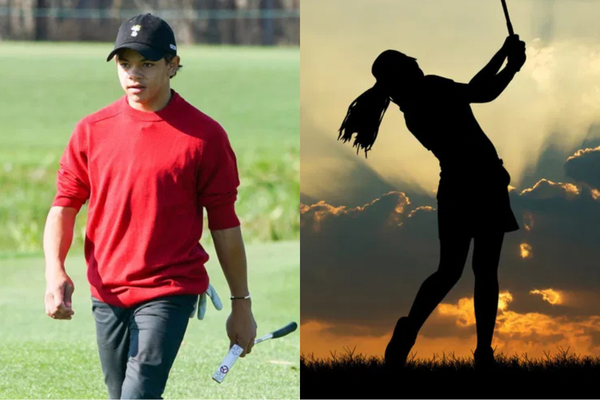
via Imago
Charlie Woods – Female Golfer Silhouette Image Credit: Imago

via Imago
Charlie Woods – Female Golfer Silhouette Image Credit: Imago
Athletes can now profit monetarily from their talent and fame without waiting to become professionals, thanks to social media endorsements and brand partnerships. Since the NCAA introduced NIL options for student-athletes, brands can collaborate with young players, providing them an opportunity to monetize their popularity early. The landscape has shifted so dramatically that companies are now betting on emerging talent before they reach the spotlight.
The impact has been particularly visible in golf, where rising stars have secured significant deals. Nick Dunlap leveraged Adidas and TaylorMade sponsorships while remaining amateur, Miles Russell commands partnerships with Nike and TaylorMade at just 16, and Blades Brown, AJGA’s No. 1, reportedly earns around $50,000 annually through NIL deals. Yet amidst this gold rush, one of golf’s most-watched young talents is taking a markedly different approach.
ADVERTISEMENT
Article continues below this ad
Keeping it traditional: The Woods approach
Charlie Woods‘ high school golf coach is crystal clear about the 16-year-old’s stance on NIL opportunities. “They’re smart enough to know what’s good, what’s not good,” Harbeck said of the Woods family. “I’m sure someone’s going to approach him with [NIL] … but they’re so smart and they’ve got such good people around them that I think the only thing we need to be careful of is making sure we’re all aware of what’s going on − and that deals with all kids.”
The young Woods has been making significant strides in his golf career. In December 2024, he made headlines at the PNC Championship, carding his first-ever hole-in-one during the final round at the Ritz-Carlton GC. Using a 7-iron on the 176-yard par-3 4th hole, Charlie helped Team Woods set a tournament scoring record of 28-under (59-57) across two rounds, though they ultimately finished runners-up. His competitive schedule has been busy, with notable performances, including a T2 finish at the Martin Downs Medalist Tour and contributing to The Benjamin School’s district championship victory in November 2024.
Harbeck, who knows the Woods family well, would be “shocked” and “surprised” if Charlie signed any NIL deals that came his way. “Obviously, someone’s going to go in on Charlie, but I doubt they’ll accept it,” he explained. “I know them too well.” The reasoning behind the Woods family’s approach cuts to the core of their values. “He doesn’t need the fame. He’s got that. He surely doesn’t need the money. So what’s the benefit of Charlie receiving NIL money? Is there one? I don’t know,” Harbeck pondered. At the heart of this philosophy lies Tiger Woods‘ singular focus: “All Tiger wants to do is keep the kid in Charlie.”
New era, new path: The contrasting journeys
This philosophy stands in stark contrast to his schoolmate Kai Trump’s recent moves. The 17-year-old granddaughter of President Donald Trump has embraced the NIL era, signing a deal with Leaf Trading Cards in January 2025. Her NIL valuation of $1.2 million ranks her No. 1 in women’s high school golf and No. 81 overall in NIL rankings, driven by her substantial social media following of over 5 million across platforms.
ADVERTISEMENT
Article continues below this ad
View this post on Instagram
These contrasting paths represent a broader shift in junior golf development. While the Woods family maintains a traditional approach focused purely on competitive growth, Kai Trump exemplifies the modern pathway where young athletes can build their brands alongside their game. Her successful fusion of social media influence with golf achievements offers a blueprint for the next generation of players looking to capitalize on their talent early.
ADVERTISEMENT
Article continues below this ad
The impact of these divergent approaches extends beyond their individual journeys. As NIL deals become increasingly prevalent in junior golf, with some athletes securing six-figure agreements before entering college, these two high-profile teenagers are inadvertently shaping how future players might navigate their early careers. Their stories suggest that success in modern golf isn’t a one-size-fits-all proposition but rather a personal choice between tradition and innovation, between pure athletic focus and brand development.
As junior golf continues to evolve, their contrasting philosophies offer valuable insights for the next generation of players. What’s your take on these different approaches to junior golf development? Let us know in the comments section below!
ADVERTISEMENT
ADVERTISEMENT
ADVERTISEMENT
ADVERTISEMENT

